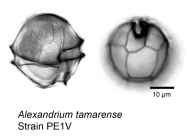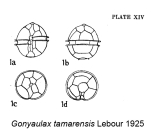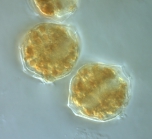Scheldt species taxon details
Alexandrium tamarense (Lebour) Balech, 1995
109714 (urn:lsid:marinespecies.org:taxname:109714)
accepted
Species
marine
(of ) Lebour, M.V. (1925). The Dinoflagellates of Northern Seas. <em>The Marine Biological Association of the United Kingdom.</em> 250 pp. [details] Available for editors 
Guiry, M.D. & Guiry, G.M. (2025). AlgaeBase. World-wide electronic publication, National University of Ireland, Galway (taxonomic information republished from AlgaeBase with permission of M.D. Guiry). Alexandrium tamarense (Lebour) Balech, 1995. Accessed through: VLIZ Consortium Scheldt Species Register at: https://scheldemonitor.be/speciesregister/aphia.php?p=taxdetails&id=109714 on 2025-09-11
VLIZ Consortium. Scheldt Species Register. Alexandrium tamarense (Lebour) Balech, 1995. Accessed at: https://www.scheldemonitor.org/speciesregister/aphia.php?p=taxdetails&id=109714 on 2025-09-11
Date
action
by
2006-07-27 06:59:07Z
changed
Camba Reu, Cibran
2015-06-26 12:00:51Z
changed
db_admin
original description
(of ) Lebour, M.V. (1925). The Dinoflagellates of Northern Seas. <em>The Marine Biological Association of the United Kingdom.</em> 250 pp. [details] Available for editors 
basis of record Guiry, M.D. & Guiry, G.M. (2025). AlgaeBase. <em>World-wide electronic publication, National University of Ireland, Galway.</em> searched on YYYY-MM-DD., available online at http://www.algaebase.org [details]
basis of record Gómez, F. (2005). A list of free-living dinoflagellate species in the world's oceans. <em>Acta Bot. Croat.</em> 64(1): 129-212. [details]
additional source Orr, R. J.; Stüken, A.; Rundberget, T.; Eikrem, W.; Jakobsen, K. S. (2011). Improved phylogenetic resolution of toxic and non-toxic <i>Alexandrium</i> strains using a concatenated rDNA approach. <em>Harmful Algae.</em> 10(6): 676-688., available online at https://doi.org/10.1016/j.hal.2011.05.003 [details]
additional source Balech, E. (2002). Dinoflagelados tecados tóxicos en el Cono Sur Americano. <em>In: Sar, E.A., Ferrario, M.E. & Reguera, B. (Eds.). Floraciones Algales Nocivas en el Cono Sur Americano. Instituto Español de Oceanografía.</em> pp. 123-144. [details] Available for editors
additional source Higman, W. A.; Stone, D. M.; Lewis, J. M. (2001). Sequence comparisons of toxic and non-toxic <i>Alexandrium tamarense</i> (Dinophyceae) isolates from UK waters. <em>Phycologia.</em> 40(3): 256-262., available online at https://doi.org/10.2216/i0031-8884-40-3-256.1 [details]
additional source Zou, C.; Ye, R.-M.; Zheng, J.-W.; Luo, Z.-H.; Gu, H.-F.; Yang, W.-D.; Li, H.-Y.; Liu, J.-S. (2014). Molecular phylogeny and PSP toxin profile of the <i>Alexandrium tamarense</i> species complex along the coast of China. <em>Marine Pollution Bulletin.</em> 89(1-2): 209-219., available online at https://doi.org/10.1016/j.marpolbul.2014.09.056 [details]
additional source Guiry, M.D. & Guiry, G.M. (2025). AlgaeBase. <em>World-wide electronic publication, National University of Ireland, Galway.</em> searched on YYYY-MM-DD., available online at http://www.algaebase.org [details]
additional source Tomas, C.R. (Ed.). (1997). Identifying marine phytoplankton. Academic Press: San Diego, CA [etc.] (USA). ISBN 0-12-693018-X. XV, 858 pp., available online at http://www.sciencedirect.com/science/book/9780126930184 [details]
additional source Brandt, S. (2001). Dinoflagellates, <B><I>in</I></B>: Costello, M.J. <i>et al.</i> (Ed.) (2001). <i>European register of marine species: a check-list of the marine species in Europe and a bibliography of guides to their identification. Collection Patrimoines Naturels,</i> 50: pp. 47-53 (look up in IMIS) [details]
additional source Scott, F.J.; Marchant, H.J. (Ed.). (2005). Antarctic marine protists. <em>Australian Biological Resources Study: Canberra.</em> ISBN 0-642-56835-9. 563 pp., available online at http://its-db.aad.gov.au/proms/pubn/pubshow.asp?pub_id=12140 [details]
additional source Balech, E. 1995. The Genus <i>Alexandrium</i> Halim (Dinoflagellata). Sherkin Island Marine Station, Sherkin Island, Co. Cork, Ireland, 151. [details] Available for editors
additional source Moestrup, Ø., Akselman, R., Cronberg, G., Elbraechter, M., Fraga, S., Halim, Y., Hansen, G., Hoppenrath, M., Larsen, J., Lundholm, N., Nguyen, L. N., Zingone, A. (Eds) (2009 onwards). IOC-UNESCO Taxonomic Reference List of Harmful Micro Algae., available online at http://www.marinespecies.org/HAB [details]
additional source Chang, F.H.; Charleston, W.A.G.; McKenna, P.B.; Clowes, C.D.; Wilson, G.J.; Broady, P.A. (2012). Phylum Myzozoa: dinoflagellates, perkinsids, ellobiopsids, sporozoans, in: Gordon, D.P. (Ed.) (2012). New Zealand inventory of biodiversity: 3. Kingdoms Bacteria, Protozoa, Chromista, Plantae, Fungi. pp. 175-216. [details]
redescription John, U.; Litaker, R. W.; Montresor, M.; Murray, S.; Brosnahan, M. L.; Anderson, D. M. (2014). Formal revision of the <i>Alexandrium tamarense</i> species complex (Dinophyceae) taxonomy: The introduction of five species with emphasis on molecular-based (rDNA) cassification. <em>Protist.</em> 165(6): 779-804., available online at https://doi.org/10.1016/j.protis.2014.10.001 [details]
new combination reference Balech, E. (1985). The genus <i>Alexandrium</i> or <i>Gonyaulax</i> of the <i>tamarensis</i> group. In: D.M. Anderson, A.W. White and D.G. Baden (Eds.) Toxic Dinoflagellates. New York: Elsevier. P. 33–38. [details] Available for editors
toxicology source Lugliè, A.; Giacobbe, M. G.; Riccardi, E.; Bruno, M.; Pigozzi, S.; Mariani, M. A.; Satta, C. T.; Stacca, D.; Bazzoni, A. M.; Caddeo, T.; Farina, P.; Padedda, B. M.; Pulina, S.; Sechi, N.; Milandri, A. (2017). Paralytic Shellfish Toxins and Cyanotoxins in the Mediterranean: New Data from Sardinia and Sicily (Italy). <em>Microorganisms.</em> 5(4): 72., available online at https://doi.org/10.3390/microorganisms5040072
note: A. tamarense strain CNR–ATA6PT showed moderate toxicity, especially due to GTX5, GTX1 and GTX4 [details] Available for editors
ecology source Jeong, H.; Yoo, Y.; Park, J.; Song, J.; Kim, S.; Lee, S.; Kim, K.; Yih, W. (2005). Feeding by phototrophic red-tide dinoflagellates: five species newly revealed and six species previously known to be mixotrophic. <em>Aquatic Microbial Ecology.</em> 40: 133-150., available online at https://doi.org/10.3354/ame040133 [details]
basis of record Guiry, M.D. & Guiry, G.M. (2025). AlgaeBase. <em>World-wide electronic publication, National University of Ireland, Galway.</em> searched on YYYY-MM-DD., available online at http://www.algaebase.org [details]
basis of record Gómez, F. (2005). A list of free-living dinoflagellate species in the world's oceans. <em>Acta Bot. Croat.</em> 64(1): 129-212. [details]
additional source Orr, R. J.; Stüken, A.; Rundberget, T.; Eikrem, W.; Jakobsen, K. S. (2011). Improved phylogenetic resolution of toxic and non-toxic <i>Alexandrium</i> strains using a concatenated rDNA approach. <em>Harmful Algae.</em> 10(6): 676-688., available online at https://doi.org/10.1016/j.hal.2011.05.003 [details]
additional source Balech, E. (2002). Dinoflagelados tecados tóxicos en el Cono Sur Americano. <em>In: Sar, E.A., Ferrario, M.E. & Reguera, B. (Eds.). Floraciones Algales Nocivas en el Cono Sur Americano. Instituto Español de Oceanografía.</em> pp. 123-144. [details] Available for editors
additional source Higman, W. A.; Stone, D. M.; Lewis, J. M. (2001). Sequence comparisons of toxic and non-toxic <i>Alexandrium tamarense</i> (Dinophyceae) isolates from UK waters. <em>Phycologia.</em> 40(3): 256-262., available online at https://doi.org/10.2216/i0031-8884-40-3-256.1 [details]
additional source Zou, C.; Ye, R.-M.; Zheng, J.-W.; Luo, Z.-H.; Gu, H.-F.; Yang, W.-D.; Li, H.-Y.; Liu, J.-S. (2014). Molecular phylogeny and PSP toxin profile of the <i>Alexandrium tamarense</i> species complex along the coast of China. <em>Marine Pollution Bulletin.</em> 89(1-2): 209-219., available online at https://doi.org/10.1016/j.marpolbul.2014.09.056 [details]
additional source Guiry, M.D. & Guiry, G.M. (2025). AlgaeBase. <em>World-wide electronic publication, National University of Ireland, Galway.</em> searched on YYYY-MM-DD., available online at http://www.algaebase.org [details]
additional source Tomas, C.R. (Ed.). (1997). Identifying marine phytoplankton. Academic Press: San Diego, CA [etc.] (USA). ISBN 0-12-693018-X. XV, 858 pp., available online at http://www.sciencedirect.com/science/book/9780126930184 [details]
additional source Brandt, S. (2001). Dinoflagellates, <B><I>in</I></B>: Costello, M.J. <i>et al.</i> (Ed.) (2001). <i>European register of marine species: a check-list of the marine species in Europe and a bibliography of guides to their identification. Collection Patrimoines Naturels,</i> 50: pp. 47-53 (look up in IMIS) [details]
additional source Scott, F.J.; Marchant, H.J. (Ed.). (2005). Antarctic marine protists. <em>Australian Biological Resources Study: Canberra.</em> ISBN 0-642-56835-9. 563 pp., available online at http://its-db.aad.gov.au/proms/pubn/pubshow.asp?pub_id=12140 [details]
additional source Balech, E. 1995. The Genus <i>Alexandrium</i> Halim (Dinoflagellata). Sherkin Island Marine Station, Sherkin Island, Co. Cork, Ireland, 151. [details] Available for editors
additional source Moestrup, Ø., Akselman, R., Cronberg, G., Elbraechter, M., Fraga, S., Halim, Y., Hansen, G., Hoppenrath, M., Larsen, J., Lundholm, N., Nguyen, L. N., Zingone, A. (Eds) (2009 onwards). IOC-UNESCO Taxonomic Reference List of Harmful Micro Algae., available online at http://www.marinespecies.org/HAB [details]
additional source Chang, F.H.; Charleston, W.A.G.; McKenna, P.B.; Clowes, C.D.; Wilson, G.J.; Broady, P.A. (2012). Phylum Myzozoa: dinoflagellates, perkinsids, ellobiopsids, sporozoans, in: Gordon, D.P. (Ed.) (2012). New Zealand inventory of biodiversity: 3. Kingdoms Bacteria, Protozoa, Chromista, Plantae, Fungi. pp. 175-216. [details]
redescription John, U.; Litaker, R. W.; Montresor, M.; Murray, S.; Brosnahan, M. L.; Anderson, D. M. (2014). Formal revision of the <i>Alexandrium tamarense</i> species complex (Dinophyceae) taxonomy: The introduction of five species with emphasis on molecular-based (rDNA) cassification. <em>Protist.</em> 165(6): 779-804., available online at https://doi.org/10.1016/j.protis.2014.10.001 [details]
new combination reference Balech, E. (1985). The genus <i>Alexandrium</i> or <i>Gonyaulax</i> of the <i>tamarensis</i> group. In: D.M. Anderson, A.W. White and D.G. Baden (Eds.) Toxic Dinoflagellates. New York: Elsevier. P. 33–38. [details] Available for editors
toxicology source Lugliè, A.; Giacobbe, M. G.; Riccardi, E.; Bruno, M.; Pigozzi, S.; Mariani, M. A.; Satta, C. T.; Stacca, D.; Bazzoni, A. M.; Caddeo, T.; Farina, P.; Padedda, B. M.; Pulina, S.; Sechi, N.; Milandri, A. (2017). Paralytic Shellfish Toxins and Cyanotoxins in the Mediterranean: New Data from Sardinia and Sicily (Italy). <em>Microorganisms.</em> 5(4): 72., available online at https://doi.org/10.3390/microorganisms5040072
note: A. tamarense strain CNR–ATA6PT showed moderate toxicity, especially due to GTX5, GTX1 and GTX4 [details] Available for editors
ecology source Jeong, H.; Yoo, Y.; Park, J.; Song, J.; Kim, S.; Lee, S.; Kim, K.; Yih, W. (2005). Feeding by phototrophic red-tide dinoflagellates: five species newly revealed and six species previously known to be mixotrophic. <em>Aquatic Microbial Ecology.</em> 40: 133-150., available online at https://doi.org/10.3354/ame040133 [details]
 Present
Present  Inaccurate
Inaccurate  Introduced: alien
Introduced: alien  Containing type locality
Containing type locality
Published in AlgaeBase 
To Barcode of Life (6 barcodes)
To Biodiversity Heritage Library (10 publications)
To Dyntaxa
To European Nucleotide Archive, ENA (Alexandrium tamarense)
To GenBank (683291 nucleotides; 144 proteins)
To Global Biotic Interactions (GloBI)
To Information system on Aquatic Non-Indigenous and Cryptogenic Species (AquaNIS)
To PESI
To ITIS

To Barcode of Life (6 barcodes)
To Biodiversity Heritage Library (10 publications)
To Dyntaxa
To European Nucleotide Archive, ENA (Alexandrium tamarense)
To GenBank (683291 nucleotides; 144 proteins)
To Global Biotic Interactions (GloBI)
To Information system on Aquatic Non-Indigenous and Cryptogenic Species (AquaNIS)
To PESI
To ITIS



